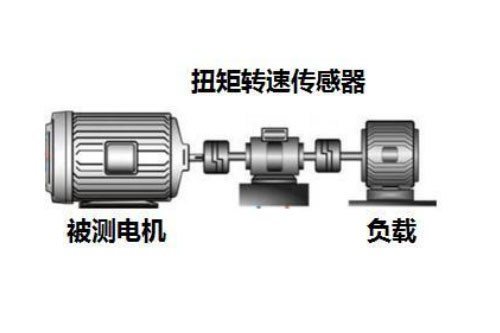
In the motor test system, the torque measurement is often achieved through a torque sensor. The following figure shows a typical motor torque test method:
The motor under test is connected to the torque sensor via a coupling, and the other end of the torque sensor is connected to the load motor via a coupling. When the system is working, the motor under test operates in the speed loop (or torque loop). The load motor works in the torque loop (or speed loop). The torque sensor measures the torque and transmits the torque value to the measuring instrument. Understand the torque test process, we can find the key factors of the torque test, the first: the measurement accuracy of the torque sensor; second: the measurement accuracy of the test instrument; third: the torque loading accuracy of the motor (measured and loaded); Fourth: The mechanical installation accuracy of the system. Next we analyze each factor point.
The first is the measurement accuracy of the torque sensor. Some people say that the torque sensor is very simple, each sensor has a nominal accuracy, and you can know directly by looking at its manual data. It is true that both domestic and foreign torque sensors have their own nominal measurement accuracy, but torque sensors have their own measuring range. How to choose the right range is also a crucial factor. Here we recommend a "three-five principle", the so-called "three-five principle" when the test torque is within 1N.m, in order to ensure measurement accuracy, the proposed measurement range is not less than one-third of the range, such as the range of 1N The .m sensor is recommended to measure 0.33Nm minimum; when the measurement torque is above 1N.m, to ensure the measurement accuracy, the recommended measurement range is not less than one-fifth of the range, such as the sensor with a range of 10N.m. Measured to 2N.m. Only in this way can the measurement accuracy of the torque sensor be guaranteed.
The measurement accuracy of the second test instrument, the traditional motor test system is the use of electrical parameters, torque meter and other discrete instruments to measure the electrical parameters and torque speed parameters are measured separately, in the steady state, the measurement accuracy can be guaranteed, once the transient parameters The measurement will greatly affect the measurement accuracy. Therefore, in the case of transient tests, high-precision measurement instruments such as power analyzers must be used to measure the electrical parameters and the torque speed test synchronously to maintain the accuracy of the measurement data.
The third torque loading accuracy, when we can guarantee measurement accuracy, must consider the loading accuracy of the system. For example, when the system is testing, when we want to test the torque point of 5N.m, we send instructions to the controller to control the motor to load. At this time, the system must be able to monitor the actual torque, and adjust the torque in real time to ensure the output torque. At 5N.m (error size depends on the degree of PID control optimization).
The mechanical installation accuracy of the fourth system and the low mechanical installation accuracy mean that the mechanical centering angle of the test bench is greatly deviated. When the motor test system is operated for a long period of time, the test bench deformation, abnormal vibration, screw off, and coupling will occur. Problems such as fractures. Therefore, it is necessary to ensure the accuracy of the alignment, otherwise anything previously done will be turned into nothingness.
Winder ® FRP Membrane pressure vessels provides standard FRP pressure vessels and its auxiliary components applicable for international RO, NF, UF, and MF etc.
Non-standard products could be tailor-made and OEM service will also be provided as per requirement to meet the satisfaction of customers.
We adopt the world advanced technology and techniques, offer the precision test and to ensure the best quality and the stable performance. Our product is used in food and beverage, pharmaceutical and chemical, power and electronics, metallurgy and petrochemical, seawater and brackish water desalination, and the others many business areas.
ASME standard complied pressure vessels are available!
Suitable for membrane elements: 1-8 elements
DOW, HYDRANAUTICS, CSM, TORAY, VONTRON, GE, KOCH, BDX, Other standard membrane elements
Paint Color Options:White color is standard, other color also available. (O: Original color L: Logo color)
Drawings
Please contact cdfrp@hotmail.com for detailed drawings!
Winder Series FRP Pressure Vessel
FRP Pressure Vessel,FRP Tanks Pressure Vessel,Membrane Pressure Vessel,FRP Water Softening Tanks
HEBEI CHENGDA HUAMO TECHNOLOGY CO.,LTD , https://www.chengdapipe.com